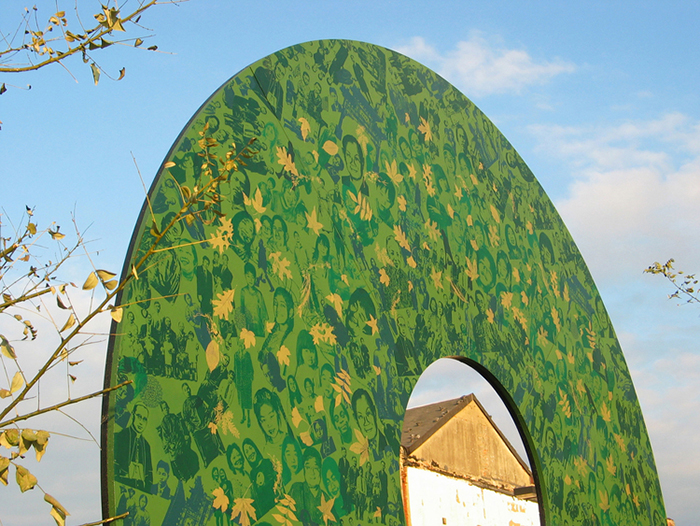In the September 2014 national Asian and Pacific Islander Americans in Historic Preservation (APIAHiP) Forum, preservationists, historians, planners, and advocates of Asian and Pacific Islander culture in America gathered to address issues of cultural heritage and how to strengthen representation at both state and national levels of government.
Although many assume historical preservation solely involves the structural maintenance of architecture and monuments, it also involves encouraging and inspiring communities to recommit to the places where they live and work. During one session of the conference, three leaders in the arts—Gayle Isa, Tomie Arai, and Genevieve Erin O’Brien—confronted reasons why communities who help build and sustain buildings become displaced by outside developers and institutional indifference. Their practices acknowledge the power of art as a catalyst for social change, treating cities made of concrete, metal, and glass as malleable labs for social experimentation and community engagement.
Isa founded the Asia Arts Initiative in Philadelphia’s Chinatown in response to community concerns about rising racial tensions. Their workshops and events involve people of all ages and races in the community to invite discussion and critical thinking about the space they live in.

HOT TEA (2013) is an example of a project from Asian Arts Initiative’s Social Practice Lab. An artist collective of Laura Deutch, Lee Tusman, Kathryn Sclavi, and Katya Gorker operated a bicycle-driven cart containing everything required to brew a pot of tea. They made stops on sidewalks along northern parts of Chinatown to share tea and create gathering spaces in otherwise unutilized spaces. The simple act of inviting strangers to drink tea in public attracted opportunities for communal bonding, from musical performances to film screenings. The tiny scarlet red cart, often surrounded by neighbors engaged in congenial conversation who had remained strangers until the moment it appeared, was an uncommon “happening” for the area, which in itself draws attention to the need for increased human interaction.
Tomie Arai, an artist based in New York City, creates permanent art installations that occupy public places from subway stations to local parks. Her works draw upon her experiences and concerns as an Asian American woman, transcending most public art’s preoccupation with aesthetic pleasure by instead reflecting on the often disregarded ethnic history of a space.

Her wood and steel sculpture “Swirl” (2006) responds directly to Mayor John Street’s plans to build a massive baseball stadium for the Philadelphia Phillies and an eight-lane highway that would bulldoze the local community center and cut Chinatown in half. The work, displaying family pictures contributed by community members and silkscreened on the shape of a Chinese jade bi, stands defiantly in the middle of the Vine Street Expressway, a distilled version of original highway plans, as a reminder of and tribute to the Chinese immigrants who helped lay the foundation for the very town that has become highly desirable real estate. The story of Philadelphia’s Chinatown under threat is common to many Chinatowns across the United States, which are being gentrified, forcing out many of its original residents.

Performance art can invite discussion through interaction and reaction. Genevieve Erin O’Brien, born to a Vietnamese mother and Irish American father, explores the underlying ethnic exclusion in American monuments. In her work Vietnamese Suitcase, O’Brien performed Vietnamese mourning rituals at Vietnam memorials in cities such as Los Angeles, Chicago, and Washington, D.C.
The ceremony, which involves burning incense and joss paper, attracted negative attention from park officials, who interpreted her peaceful actions as threatening. She often had to obtain special permits or official documents to respect the dead in the manner of her cultural tradition, highlighting how complicated bureaucratic systems exclude certain communities from access and expression.
These examples of art in public spaces reflect APIAHiP’s mission to preserve cultural heritage through a variety of means. Historic and cultural preservation require the collaborative efforts of many different parties, including public or government agencies. But these artists demonstrate how the largest responsibility ultimately falls upon the shoulders of the communities themselves, to be self-motivated and take immediate action.
Danielle Wu is a former Katzenberger Art History intern for the Smithsonian Center for Folklife and Cultural Heritage. She now lives and works in New York City.


